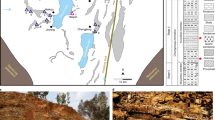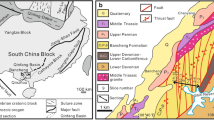Abstract
Living coelacanths (Latimeria chalumnae) are normally found only in the western Indian Ocean, where they inhabit submarine caves in the Comores Islands1. Two specimens have since been caught off the island of Manado Tua, north Sulawesi, Indonesia, some 10,000 kilometres away2. We sought to determine the ecological and geographic distribution of Indonesian coelacanth populations with a view to drawing up conservation measures for this extremely rare fish2,3. During our explorations, we discovered two living Indonesian coelacanths 360 km southwest of Manado Tua.
Similar content being viewed by others
Main
Analysis of mitochondrial DNA from a single Indonesian specimen, described as a distinct species, L. menadoensis4, revealed significant differences with the published mitochondrial genome of L. chalumnae. These differences indicate that the Indonesian and Comoran coelacanths diverged 1.8–11.0 million years ago5.
In an attempt to find more fish, we performed a total of 34 dives in the research submersible JAGO down to a depth of 400 metres at points along the northern coast of Sulawesi, the Sangihe islands and the Bay of Tomini in central Sulawesi. We failed to find any coelacanths during seven dives off Manado Tua, where the two previously reported coelacanths were caught2, but 360 km southwest of Manado Tua we found two coelacanths approximately 120 and 140 cm long in a deep carbonate cave at a depth of 155 m (water temperature, 17.8–20.1 °C).
The substrate and oceanographic conditions in the Indonesian and Comoran dive sites are completely different. The Comores have steep, young volcanic slopes with numerous lava caves, whereas the slopes of the Indonesian dive sites are older, more eroded and less steep, with very few caves, and these are mainly carbonate in origin. The Indonesian sites are exposed to strong currents (with an estimated peak velocity of 3–4 knots) of variable directions and with sudden up- and downwellings. In contrast, the Comoran habitat is frequently devoid of currents, and these are slower than 1 knot.
These differences may be important, as Comoran coelacanths are sluggish, nocturnal drift hunters that feed on other fish and have a low metabolic rate6. During the day, they retreat to the still water of deep lava caves1. The Indonesian sites would therefore seem to be unsuitable for sustaining a viable population of L. chalumnae.
So far, four Indonesian coelacanths have been found in a relatively small area along the north Sulawesi coast. We suggest that the population is very small and requires strict conservation measures. But we cannot exclude the possibility that the coelacanths of north Sulawesi are derived from a different area and drifted there with oceanic currents. The dominant current driving Indonesian throughflow water in the area of north Sulawesi is the southerly Mindanao current7, indicating that the potential source population may be in the southern Philippines or remote Pacific islands.
Furthermore, geological evidence and our genetic studies of the Comoran population indicate a young age for this population of less than 100,000 years. The reported older genetic separation of the Indonesian coelacanth of more than 1 million years would suggest that Comoran L. chalumnae probably derived from a third, as yet unknown, population.
The biogeography of the new coelacanth population remains enigmatic, although perhaps this is for the best. An undiscovered home is probably the best possible protection for these endangered fish.
References
Fricke, H. & Hissmann, K. Mar. Biol. 120, 171–180 (1994).
Erdmann, M. V, Caldwell, R. L. & Moosa, M. K. Nature 395, 335 (1998).
Forey, P. L. Nature 395, 319–320 (1998).
Pouyaud, L. et al. C. R. Acad. Sci. 322, 261–267 (1999).
Holder, M. T et al. Proc. Natl Acad. Sci.USA 96, 12616–12620 (1999).
Fricke, H. & Hissmann, K. Mar. Biol. (in the press).
Gordon, A. L. & Fine, R. A. Nature 379, 146–149 (1996).
Author information
Authors and Affiliations
Corresponding author
Rights and permissions
About this article
Cite this article
Fricke, H., Hissmann, K., Schauer, J. et al. Biogeography of the Indonesian coelacanths. Nature 403, 38 (2000). https://doi.org/10.1038/47400
Issue Date:
DOI: https://doi.org/10.1038/47400
This article is cited by
-
Buoyancy and hydrostatic balance in a West Indian Ocean coelacanth Latimeria chalumnae
BMC Biology (2022)
-
A thirteen-million-year divergence between two lineages of Indonesian coelacanths
Scientific Reports (2020)
-
Allometric growth in the extant coelacanth lung during ontogenetic development
Nature Communications (2015)
-
The population biology of the living coelacanth studied over 21 years
Marine Biology (2011)
Comments
By submitting a comment you agree to abide by our Terms and Community Guidelines. If you find something abusive or that does not comply with our terms or guidelines please flag it as inappropriate.



